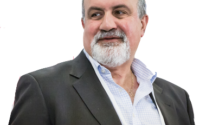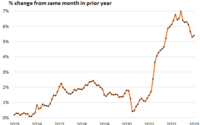WRAPUP 1-Fed, split over opening rate bid, may put weight on February data
By Howard Schneider
WASHINGTON, Feb 14 (Reuters) – U.S. Federal Reserve officials continued sparring over how aggressively to begin upcoming interest rate increases at their March meeting, with a final inflation reading just ahead of the two-day session taking on potentially outsized importance.
St. Louis Federal Reserve President James Bullard on Monday reiterated calls for a faster pace of Fed interest rate hikes, saying that four strong inflation reports in a row warranted more aggressive action and that the central bank needed to “ratify” market expectations about its upcoming moves.
Bullard, who himself helped shape those expectations with calls last week for a 50 basis point increase at the Fed’s March meeting, said on CNBC that the Fed’s “credibility is on the line” in its quest to bring inflation down from the current 40-year high of more than 7%.
“It was really October, November, December, January that called into question any idea that this inflation was naturally going to moderate in any reasonable time frame without the Fed taking action,” said Bullard, again calling for a full percentage point of Fed rate increases by July 1. That implies at least one hike of a half percentage point at one of the three meetings between now and then instead of the quarter point increases that the Fed has used in recent years.
As he spoke bond yields again rose and recent market volatility continued. The 10-year Treasury rose back above 2%, and the Dow Jones industrial average fell more than 200 points by late morning.
Other Fed officials have been less willing to commit to a half-point hike, or were even concerned it could cause trouble.
In an interview on SiriusXM radio Richmond Fed President Thomas Barkin said it was “timely” to begin raising interest rates but said the specifics will depend on how inflation moves in upcoming reports. “Will it settle back down to levels more like the levels we have seen over the last 30 years or will it not settle?” Barkin said. “Depending on the answer you could adjust your pace or your timing.”
Kansas City Fed President Esther George said in a Wall Street Journal interview that she wanted a “systematic” plan to tighten monetary policy, but was not convinced it needed to start with a 50 basis point increase.
“It is always preferable to go gradual,” George said. “Given where we are, the uncertainties around the pandemic effects and other things, I’d be hard-pressed to say we have got to get to neutral really fast,” an aim that would dictate larger and more frequent rate increases.
On Sunday, San Francisco Fed President Mary Daly said if the Fed is too “abrupt and aggressive” it could “have a destabilizing effect on the very growth and price stability that we’re trying to achieve.”
Daly told CBS’ “Face the Nation” that after raising rates in March the Fed could even consider pausing at its next meeting to evaluate the economy, a contrast to the steady increases Bullard feels will be appropriate at the Fed’s March, May and June sessions.
STAYING NIMBLE
With the Fed promising what it calls a “nimble” approach to policy after so many pandemic-era surprises, the ultimate decision may rest on the details of the final consumer inflation report, due on March 10, that the central bank will receive ahead of its meeting on the 15th and 16th of the month.
That report will show whether, as some Fed officials say they hope and expect, the month-to-month change in prices is easing, something several have said would allow them to tighten policy at a slower pace.
None of the Fed’s governors, and most notably Fed Chair Jerome Powell, have spoken publicly to the matter since the central bank’s last meeting in January.
Bullard said he would defer to Powell on the sequencing of coming rate increases. But he also said the Fed at this point needed to “follow through” on what markets anticipate, and in effect lock in the tighter financial conditions seen for example in rising interest rates for two-year Treasury notes.
Powell is “very good at managing the committee,” Bullard said. But “the Fed has to follow through and ratify those expectations that have been built into the two year, and if we don’t then it makes it appear that we are not defending” the 2% inflation target. Since the Fed began planning tighter monetary policy last fall the yield on the two-year note has risen from near zero to 1.6% as of Monday morning, roughly where it was before the pandemic.
“I think my position is a good one and I will try to convince my colleagues,” said Bullard, a voting member on Fed policy this year. (Reporting by Howard Schneider; Editing by Chizu Nomiyama and Andrea Ricci)
[ad_2]
Source link

